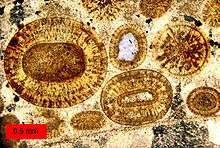Ooid
Ooids are small (commonly ≤2 mm in diameter), spheroidal, "coated" (layered) sedimentary grains, usually composed of calcium carbonate, but sometimes made up of iron- or phosphate-based minerals. Ooids usually form on the sea floor, most commonly in shallow tropical seas (around the Bahamas, for example, or in the Persian Gulf). After being buried under additional sediment, these ooid grains can be cemented together to form a sedimentary rock called an oolite. Oolites usually consist of calcium carbonate; these belong to the limestone rock family. Pisoids are similar to ooids, but are larger than 2 mm in diameter, often considerably larger, as with the pisoids in the hot springs at Carlsbad (Karlovy Vary) in the Czech Republic.



Formation
An ooid forms as a series of concentric layers around a nucleus. The layers contain crystals arranged radially, tangentially or randomly. The nucleus can be a shell fragment, quartz grain or any other small fragment. Most modern ooids are aragonite, a polymorph of calcium carbonate; some are composed of high-magnesium calcite, and some are bimineralic (layers of calcite and aragonite). Ancient ooids can be calcitic, either originally precipitated as calcite (as in calcite seas), or formed by alteration (neomorphic replacement) of aragonitic ooids (or the aragonite layers in originally bimineralic ooids). Moldic ooids (or molds later filled in by calcite cement) occur in both young and ancient rocks, indicating the removal of a soluble polymorph (usually aragonite).
Variation
Whether ooids become calcitic or aragonitic can be linked to strontium/calcium substitution within the crystalline structure. This has been shown in some examples to be due to temperature fluctuations in marine environments, which affects salinity levels, which in turn facilitate the substitution. Marine calcitic ooids were typically formed during calcite sea intervals, especially during the Ordovician and the Jurassic Periods. The geochemistry of these seas was a function of seafloor spreading and fluctuating Mg/Ca ratios. Low Mg/Ca ratios favor the precipitation of low-magnesium calcite.
Growth mode
Ooids with radial crystals (such as the aragonitic ooids in the Great Salt Lake, Utah, US) grow by ions extending the lattices of the radial crystals. The mode of growth of ooids with tangential (usually minute needle-like) crystals is less clear. They may be accumulated in a "snowball" fashion from tiny crystals in the sediment or water, or they may crystallize in place on the ooid surface. A hypothesis of growth by accretion (like a snowball) from the polymineralic sediment of fine aragonite, high-magnesium calcite (HMC) and low-magnesium calcite (LMC), must explain how only aragonite needles are added to the ooid cortex. Both in tangential and in radial ooids, the cortex is composed of many very fine increments of growth. Some modern (and ancient) ooids partially or totally lack clear layering and have a micritic (very fine grained) texture. Examination of such micritic ooids by scanning electron microscopy often shows evidence of microbial borings later filled by fine cement.
Growth factors
There are several factors that affect ooid growth: supersaturation of the water with respect to calcium carbonate, the availability of nuclei, agitation of the ooids, water depth, and the role of microbes.
References
Flügel, Erik (2010), Microfacies of Carbonate Rocks: Analysis, Interpretation and Application, 2nd ed., Springer, pp. 242–244. ISBN 978-3-642-03795-5. Accessed 2014-06-23.
External links
| Wikimedia Commons has media related to Oolite. |
| The Wikibook Historical Geology has a page on the topic of: Ooids and oolite |
- Ooid Formation at the Wayback Machine (archived 20 June 2013)